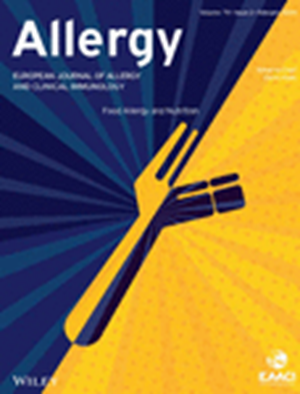Dupilumab治疗6岁以下中重度特应性皮炎儿童:一项为期16周的疗效、安全性和局部全身免疫反应的真实世界前瞻性研究
IF 12
1区 医学
Q1 ALLERGY
引用次数: 0
摘要
背景:关于dupilumab对中重度特应性皮炎(AD)患儿的临床和分子影响的现实数据仍然有限。目的评估6个月至5岁儿童dupilumab治疗16周后的临床结果、皮肤蛋白质组学变化和全身免疫反应。方法本前瞻性队列研究纳入了110名参与者,在第2、4、8、12和16周进行临床评估。纵向生物标志物分析包括皮肤胶带条带(STS)蛋白质组学,t细胞亚群的流式细胞分析和血清细胞因子多重分析。结果在96名完成研究的参与者中,70.8%达到EASI-75, 41.7%达到IGA 0/1, 84.4%报告PP-NRS改善≥4点,各年龄亚组(6个月至< 2年vs≥2至5年)的结果和不良事件具有可比性。外周血CLA+ IL-4+/IL-13+ Th2细胞明显减少(p < 0.001), CLA+ Tregs细胞明显增加(p < 0.01)。然而,治疗后血清Th2/Th1/Th17细胞因子水平保持不变或升高,特别是IL-4 (p < 0.001),尽管CCL13/17/22下降。STS蛋白质组学表明,与皮肤屏障相关的蛋白质恢复,而与表皮增生、先天免疫激活和抗菌防御相关的标记保持不变。利用机器学习算法,PON2和PRDX1都参与抗氧化过程,被确定为治疗反应的预测性生物标志物。结论:dupilumab短期治疗AD患儿表现出良好的效果,主要是通过CLA+Th2细胞的重塑和皮肤屏障功能的恢复。尽管循环Th2炎症在16周内没有完全正常化,但TARC和MDC的显著降低表明全身改善,并强调了维持治疗的重要性。本文章由计算机程序翻译,如有差异,请以英文原文为准。
Dupilumab in Children Under 6 Years With Moderate-to-Severe Atopic Dermatitis: A 16-Week Real-World Prospective Study on Efficacy, Safety, and Local-Systemic Immune Responses.
BACKGROUND
Real-world data on the clinical and molecular impacts of dupilumab in young children with moderate-to-severe atopic dermatitis (AD) remain limited.
OBJECTIVES
To evaluate 16-week clinical outcomes, cutaneous proteomic changes, and systemic immune responses to dupilumab in children aged 6 months to 5 years.
METHODS
This prospective cohort study enrolled 110 participants, with clinical evaluations performed at weeks 2, 4, 8, 12, and 16. Longitudinal biomarker profiling included skin tape strip (STS) proteomics, flow cytometric analysis of T-cell subsets, and serum cytokine multiplex assays.
RESULTS
Of the 96 participants who completed the study, 70.8% achieved EASI-75, 41.7% attained IGA 0/1, and 84.4% reported a ≥ 4-point improvement in PP-NRS, with comparable outcomes and adverse events observed across age subgroups (6 months to < 2 years vs. ≥ 2 to 5 years). Marked reductions in CLA+ IL-4+/IL-13+ Th2 cells (p < 0.001) and an expansion of CLA+ Tregs (p < 0.01) were noted in peripheral blood. However, serum Th2/Th1/Th17 cytokine levels remained unchanged or were elevated posttreatment, particularly IL-4 (p < 0.001), despite declines in CCL13/17/22. STS proteomics indicated a restoration of proteins associated with the skin barrier, while markers related to epidermal hyperplasia, innate immune activation, and antimicrobial defense remained unchanged. Utilizing machine-learning algorithms, PON2 and PRDX1, both involved in anti-oxidative processes, were identified as predictive biomarkers for treatment response.
CONCLUSIONS
Short-term dupilumab exhibited favorable outcomes in young children with AD, primarily through the remodeling of CLA+Th2 cells and the restoration of skin barrier functions. Although circulating Th2 inflammation was not completely normalized within a 16-week period, the significant reductions in TARC and MDC indicate systemic improvement and underscore the importance of maintenance therapy.
求助全文
通过发布文献求助,成功后即可免费获取论文全文。
去求助
来源期刊

Allergy
医学-过敏
CiteScore
26.10
自引率
9.70%
发文量
393
审稿时长
2 months
期刊介绍:
Allergy is an international and multidisciplinary journal that aims to advance, impact, and communicate all aspects of the discipline of Allergy/Immunology. It publishes original articles, reviews, position papers, guidelines, editorials, news and commentaries, letters to the editors, and correspondences. The journal accepts articles based on their scientific merit and quality.
Allergy seeks to maintain contact between basic and clinical Allergy/Immunology and encourages contributions from contributors and readers from all countries. In addition to its publication, Allergy also provides abstracting and indexing information. Some of the databases that include Allergy abstracts are Abstracts on Hygiene & Communicable Disease, Academic Search Alumni Edition, AgBiotech News & Information, AGRICOLA Database, Biological Abstracts, PubMed Dietary Supplement Subset, and Global Health, among others.
 求助内容:
求助内容: 应助结果提醒方式:
应助结果提醒方式:


